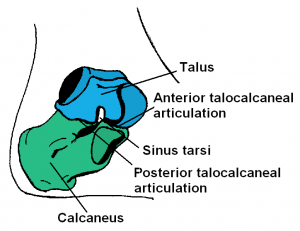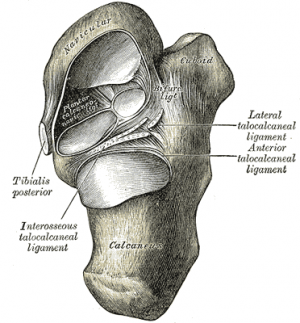Subtalar Joint: Difference between revisions
No edit summary |
No edit summary |
||
| Line 11: | Line 11: | ||
== Sub Heading 2 == | == Sub Heading 2 == | ||
[[File:Subtalar Joint.png|thumb|Subtalar Joint]] | |||
The subtalar joint is multi-articular joint, with three articulated facets that provide a surface for the joint to glide: | |||
The anterior subtalar joint (ASTJ): Allows the joint to glide forward (anterior articulation) | |||
The medial subtalar joint (MSLJ): Allows the joint to glide side-to-side (eversion/inversion) | |||
The posterior subtalar joint (PSTJ): Allows the joint to glide backward (posterior articulation) | |||
The talus and calcaneous bones are held in place by strong but flexible connective tissues called ligaments. The main ligament that attaches these bones is called the interosseous talocalcaneal ligament, which runs along a groove between them. Four other weaker ligaments provide the joint with added stability. | |||
In between the calcaneus and talus is the synovial membrane. This tissue secretes fluid to lubricate the joint space, protecting the cartilage and bones from damage. | |||
== Sub Heading 3 == | == Sub Heading 3 == | ||
Revision as of 02:43, 5 June 2022
Original Editor - Lucinda hampton
Top Contributors - Lucinda hampton, Vidya Acharya, Abbey Wright and Kim Jackson
Introduction[edit | edit source]
The subtalar joint is an articulation between two of the tarsal bones in the foot, the talus and calcaneus. The joint is classed structurally as a synovial joint, and functionally as a plane synovial joint[1].
The subtalar joint allows the foot side-to-side (inversion/eversion), pivot to change directions, and stay balanced as we move across uneven terrain. Without this joint, a person would constantly roll their ankles when running, jumping, or walking.
Sub Heading 2[edit | edit source]
The subtalar joint is multi-articular joint, with three articulated facets that provide a surface for the joint to glide:
The anterior subtalar joint (ASTJ): Allows the joint to glide forward (anterior articulation)
The medial subtalar joint (MSLJ): Allows the joint to glide side-to-side (eversion/inversion)
The posterior subtalar joint (PSTJ): Allows the joint to glide backward (posterior articulation)
The talus and calcaneous bones are held in place by strong but flexible connective tissues called ligaments. The main ligament that attaches these bones is called the interosseous talocalcaneal ligament, which runs along a groove between them. Four other weaker ligaments provide the joint with added stability.
In between the calcaneus and talus is the synovial membrane. This tissue secretes fluid to lubricate the joint space, protecting the cartilage and bones from damage.
Sub Heading 3[edit | edit source]
Resources[edit | edit source]
- bulleted list
- x
or
- numbered list
- x
References[edit | edit source]
- ↑ Teach me anatomy The subtalar loint Available:https://teachmeanatomy.info/lower-limb/joints/subtalar/ (accessed 5.6.2022)








